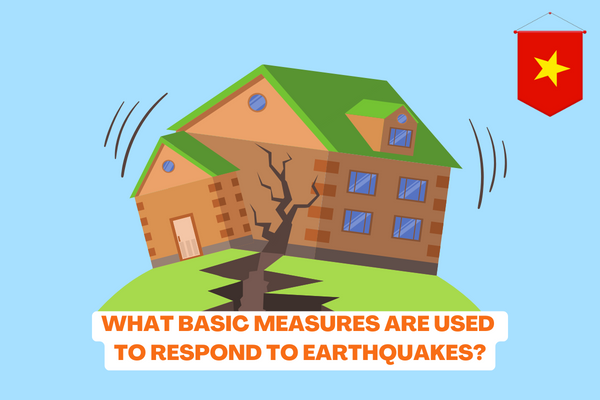Vietnam: What do earthquakes refer to? What basic measures are used to respond to earthquakes?
What do earthquakes refer to according to Vietnamese regulations?
Pursuant to Clause 1, Article 3 of the Vietnam Law on Natural Disaster Prevention and Control 2013 (amended by Point a, Clause 1, Article 1 of the Vietnam Law on Natural Disaster Prevention and Control amended in 2020) stipulates:
- “natural disaster” means an unusual natural phenomenon which may cause loss of life and property or damage to the environment, living conditions and socio- economic activities. Natural disasters include tropical storms, tropical depressions, strong breezes at seas, tornadoes, lightning, heavy precipitation, floods, flashfloods, inundations; landslides and land subsidence caused by floods or runoff or droughts; water rise, saltwater intrusion, extreme heat, droughts, wildfires, cold under 13 degree Celsius, hails, frost, fog, earthquakes, tsunamis and other types of natural disasters.”;
At the same time, pursuant to Clause 33 Article 5 of Decision 18/2021/QD-TTg, it provides as follows:
33. “earthquake” refers to the shaking of the surface of the Earth resulting from a sudden release of energy in the Earth's lithosphere that creates seismic waves capable of causing deformation and destroying houses, works, property and lives.
Accordingly, earthquakes are 1 of the unusual natural disaster phenomena. Specifically, this is the phenomenon of shaking of the surface of the Earth resulting from a sudden release of energy in the Earth's lithosphere that creates seismic waves capable of causing deformation and destroying houses, works, property and lives.

Vietnam: What do earthquakes refer to? What basic measures are used to respond to earthquakes?
How many levels of disaster risk are there due to earthquakes in Vietnam?
Pursuant to Article 55 of Decision 18/2021/QD-TTg, it provides as follows:
Article 55. Earthquake severity levels
1. Disaster severity level 1 is applicable to earthquakes with intensity from grade V to grade VI at any location in Vietnamese territory.
2. Disaster severity level 2 is applicable to earthquakes with intensity from grade VI to grade VII in rural or urban areas.
3. Disaster severity level 3 is applicable to earthquakes with intensity from grade VI to grade VII in areas where irrigation reservoirs or hydropower reservoirs are located or from grade VII to grade VIII in rural areas.
4. Disaster severity level 4 is applicable to earthquakes with intensity from grade VII to grade VIII in urban areas or areas where irrigation reservoirs or hydropower reservoirs are located.
5. Disaster severity level 5 is applicable to earthquakes with intensity higher than grade VIII at any location in Vietnamese territory.
Accordingly, earthquakes are divided into 5 levels of disaster risk as follows:
- Disaster severity level 1 is applicable to earthquakes with intensity from grade V to grade VI at any location in Vietnamese territory.
- Disaster severity level 2 is applicable to earthquakes with intensity from grade VI to grade VII in rural or urban areas.
- Disaster severity level 3 is applicable to earthquakes with intensity from grade VI to grade VII in areas where irrigation reservoirs or hydropower reservoirs are located or from grade VII to grade VIII in rural areas.
- Disaster severity level 4 is applicable to earthquakes with intensity from grade VII to grade VIII in urban areas or areas where irrigation reservoirs or hydropower reservoirs are located.
- Disaster severity level 5 is applicable to earthquakes with intensity higher than grade VIII at any location in Vietnamese territory.
What is the basic response to earthquakes in Vietnam?
Pursuant to Clause 4, Article 26 of the Vietnam Law on Natural Disaster Prevention and Control 2013 (some phrases are replaced by Clause 24, Article 1 of the Vietnam Law on Natural Disaster Prevention and Control amended in 2020) provides as follows:
Article 26. Basic measures to respond to natural disasters
Based on the types of natural disasters and levels of natural disaster risks, the Central Steering Committee for Natural Disaster Prevention and Control, the National Committee for Search and Rescue and commanding committees for natural disaster prevention and control and search and rescue at all levels shall decide to select one or several of the following measures as appropriate:
...
4. Basic measures to respond to earthquakes and tsunamis are provided as follows:
a/ Proactively taking shelter, assuring safety when an earthquake occurs;
b/ Proactively evacuating people from tsunami-affected areas;
c/ Organizing search and rescue and treatment of injured people;
d/ Arranging temporary accommodation and providing food, curative medicines, drinking water and other essentials for affected people;
dd/ Assuring security, social order and safety and protecting properties of the State and people in natural disaster-hit areas.
Accordingly, basic measures to respond to earthquakes include:
- Proactively taking shelter, assuring safety when an earthquake occurs;
- Proactively evacuating people from tsunami-affected areas;
- Organizing search and rescue and treatment of injured people;
- Arranging temporary accommodation and providing food, curative medicines, drinking water and other essentials for affected people;
- Assuring security, social order and safety and protecting properties of the State and people in natural disaster-hit areas.
LawNet
